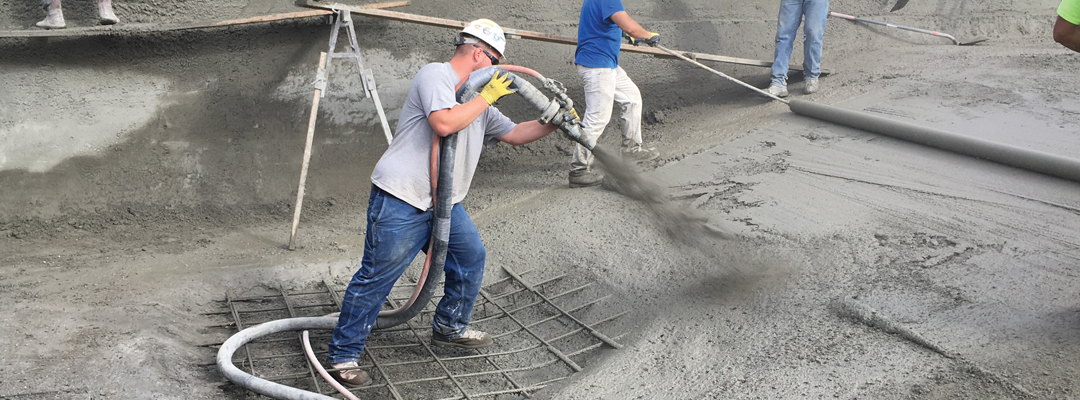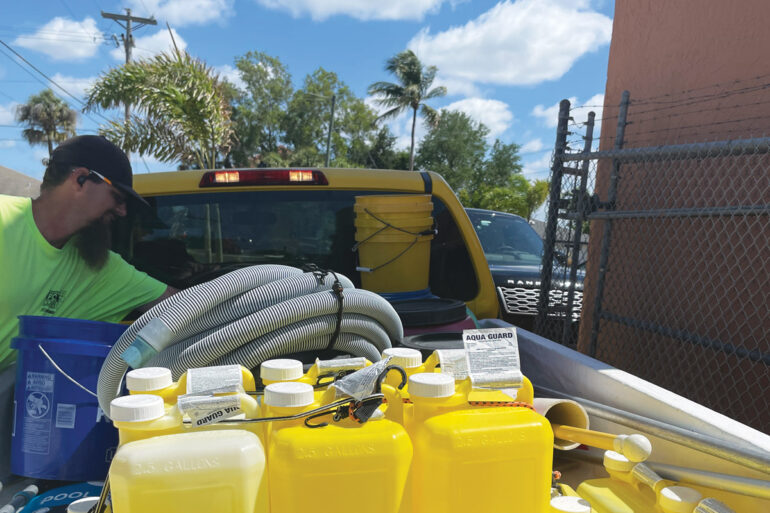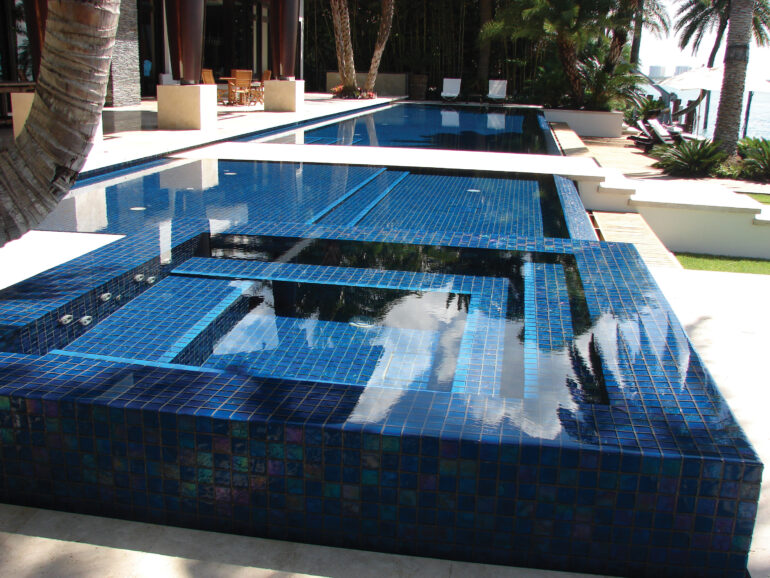Shotcrete Shock

William Drakeley grew up in the pool business. As a child, he would pick up garbage on the job site, following around the shotcrete crews. He finished school and became a banker, but he hated staying inside. So he worked for a few family pool companies and then, in 2000, started Drakeley Pool Company in Bethlehem, Connecticut.
He knew going into it that most pool businesses didn’t have the right educational training to correctly spray concrete at high velocity. So to distinguish Drakeley Pool Company, and himself from the others, he went back to school.
Drakeley trained under George Yoggy, concrete scientist and father of modern shotcrete in the United States. Over a 10-year period of study, Yoggy introduced him to the American Shotcrete Association (ASA) and the American Concrete Institute (ACI), including its technical guides, specifications and true material and application science for the sprayed concrete process.
Today, Drakeley is chairman of the ACI 506 Pool Shotcrete Committee, secretary of the ACI C660 Shotcrete Nozzlemen Certification Program, president of the ASA in 2016 and a technical shotcrete writer for several pool-trade publications.
The Basics
If you’re part of the in-ground pool industry, then you’re either using shotcrete or you’ve heard of it. However, the consensus is that many pool contractors aren’t up to date on shotcrete processes.
“When it comes to swimming pools, there is no better construction material than concrete for the structure, no matter what part of the world you are in,” says Mason Guarino, vice president of South Shore Gunite Pools & Spas, Inc. in North Billerica, Massachusetts. He learned the swimming pool industry from his father, who taught Guarino that they needed to do everything the right way, pushing for education and caring about the final product. He is now an ACI member and certified nozzleman, and is on the ASA board of directors. “Shotcrete is the most efficient way of installing concrete for a swimming pool application.”
“Shotcrete is an action and a verb,” Drakeley says. “The physical product is concrete, which is pumped or blown through a material hose and hydrated at the nozzle or in the ready-mix truck, depending on which application you use — dry shotcrete or wet shotcrete.”
As Guarino explains it, anything smaller than 1,000 square feet of water surface should be shot with dry mix over a two-day period. Anything larger than 1,000 square feet of water surface can be shot with wet or dry mix. The mix, which has a texture like toothpaste when mixed correctly, is sprayed on a rebar cage on the pool floor and walls, and it self-consolidates (is self-compacting) through air velocity (vehicle for placement), Drakeley says. Unlike cast form structures, which are two-sided, pools only need a one-sided form, which is why shotcrete is ideal.
Correct Mix and Application
Ensuring you have a quality mix design for the pool structure functionality is imperative. Guarino says the minimum wet or dry mix strength should be 4000 PSI. “This is easily accomplished in dry mix with a four to one concrete sand to cement ratio, and a good nozzleman backed up by the right equipment,” he says. For wet mix, it needs to be at least 700 pounds cementitious materials, a well-graded aggregate blend, a low slum and a water-to-cement ratio of around 0.35, Guarino explains.
For smaller pools, Guarino and his crew shotcrete the cove first and then alternate back and forth between shooting the floor and walls of the pool. For larger pool designs entirely done in shotcrete, they start with strips of the floor, followed by the coves and then alternate between floor and coves. “Once the pool is completed on a small pool, we will set up sprinklers or cover it for curing,” he says. “On a larger pool, we will work on wet curing throughout the process.”
“All shotcrete should be installed at high velocity and needs to come from the nozzle,” he says. “A good shotcrete crew will leave a decent amount of rebound outside the pool when they are done. Typically you want to see 15 to 20 percent of the material ordered outside the pool. If you have no rebound, then you have a less than ideal strength for your pool structure.”
Guarino recommends your nozzleman be ACI certified and have the right equipment, including a compressor with at least 250 CFM capacity for the wet mix process and at least 600 CFM capacity for dry mix. If the crew is using other air tools (such as an air-powered shotcrete gun, water pumps or air lances), there needs to be another compressor on site that’s at least 100 CFM larger than previously stated.
Improper velocity results in incorrect rebar encapsulation and bond strength at the joints, Guarino says. Dry mix needs enough air to reach the required velocity, something he sees many nozzlemen fail to do adequately.
Areas of Concern
Improper shotcrete installation will yield a weak structure — cracking, permeability, porosity, weak performance and more, Drakeley says, adding that he sees many common errors in shotcrete installation.
“Contractors don’t order the right mix,” he explains. “They don’t have the right amount of water, cement or aggregate. They don’t mix those ingredients properly. Applicators don’t spray them properly — at the right velocity, right angle or right distance. Crews reuse material that they shouldn’t. Pool installers don’t have the right forming, steel work or guide wires. Everything is not laid out so all involved understand the parameters of the placement.”
Guarino also sees pool builders using bad shotcrete installation habits such as completely shooting the walls first, then into the floor when using a wet mix. This creates a weakened cove, which is a critical structural point of the pool.
Drakeley attributes all of these common errors to a lack of education. The installer should understand the mix design, the proper applications of correct installation, and what that mix is going to do after it hardens. He needs to know how strong it’s going to get, how to make it watertight and if it will have enough compressive value.
“The largest percentage of sprayed shotcrete in the country involves swimming pools, and the biggest abusers of the process are swimming pool contractors,” Drakeley says. “We didn’t go to Harvard; we just grew up holding a hose and watching the guy in front of us. Whatever habits he taught, that’s what we did and what we taught the next generation. And that’s the problem. The pool guy mentality is that he’s been doing it this way for 30 years and never had a problem. First of all, he’s a liar. Secondly, he doesn’t know what he doesn’t know.”
Continually Learning
Fortunately, ACI and ASA are working on educational components that are gaining momentum within the pool industry. There is already an ACI certification for nozzlemen in place. The ASA is working toward a qualification program for contractors. Drakeley teaches a construction school for pool builders through Genesis, which includes a lot about shotcrete. He also recommends simply getting involved in ACI and ASA: “The fact that there are organizations out there that have a pool committee and most pool guys don’t get involved,” he says, “is a shame.”
The goal is to get the people writing bid documents (such as the engineers and architects) to take notice of these certification programs and require their contractors to adhere to ACI and ASA shotcrete application standards. Drakeley says engineers for high-end projects have started taking notice, and eventually it will trickle down to the average pool in the backyard.
The certification programs in the works are geared toward the engineering specifying society, and with good reason. “What we write out from our end carries weight, credibility and is a legal document that you can use in court if you have to,” Drakeley says. “That’s what the engineer specifiers need — the law of the land — and that’s what the ACI/ASA is giving them.”
Guarino’s top three tips: Use an ACI certified nozzleman; educate yourself; and join ASA. Drakeley’s top three tips: Know your materials; know the proper application process; and understand curing. “There are many shotcrete consultants who can help ensure your contractors know what they are doing and are equipped correctly,” Guarino says. “You can also submit questions to the ASA.”











